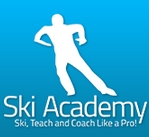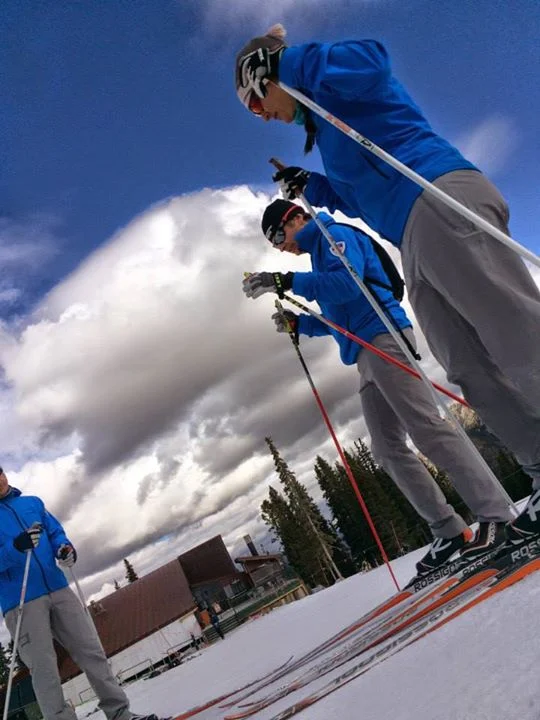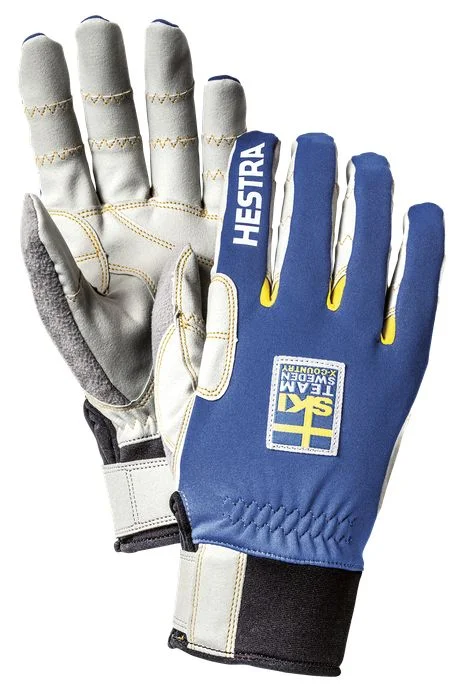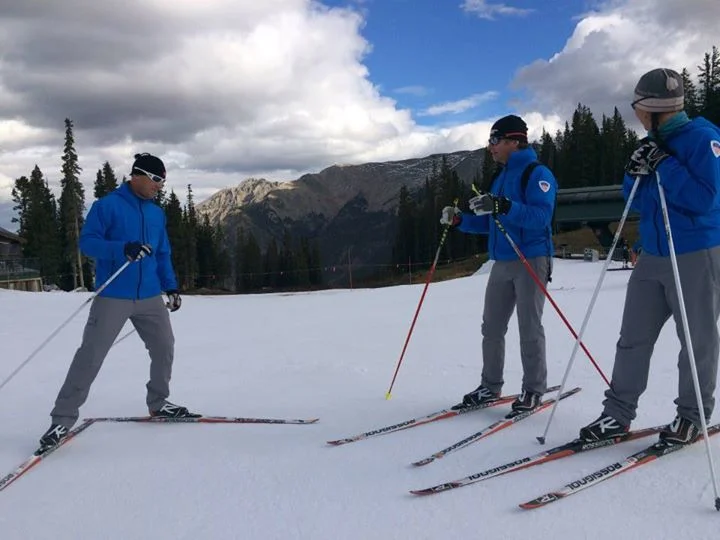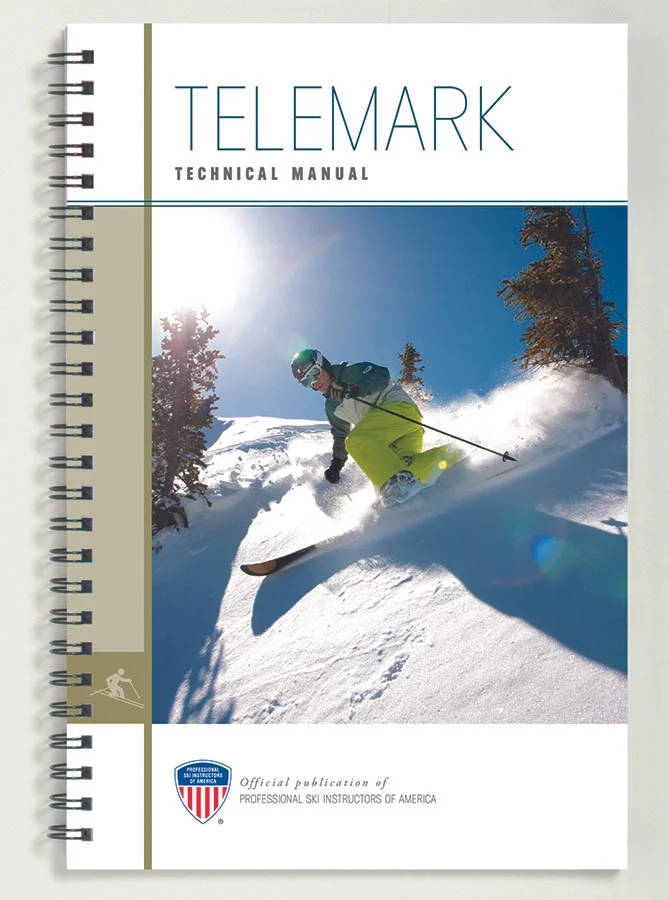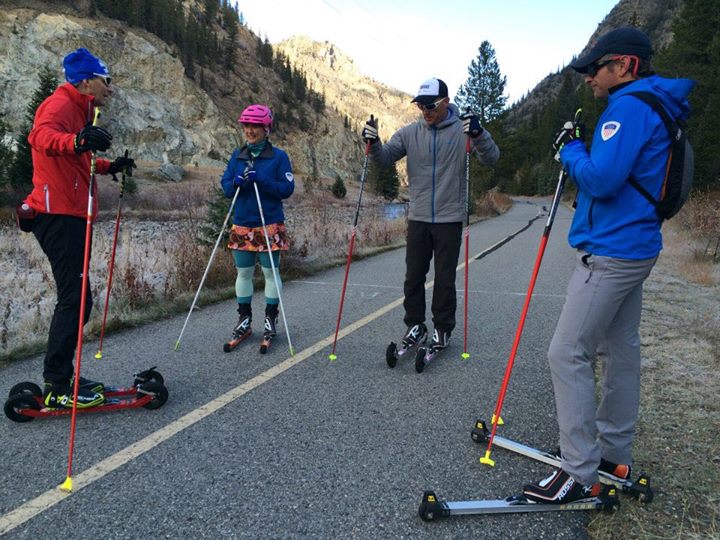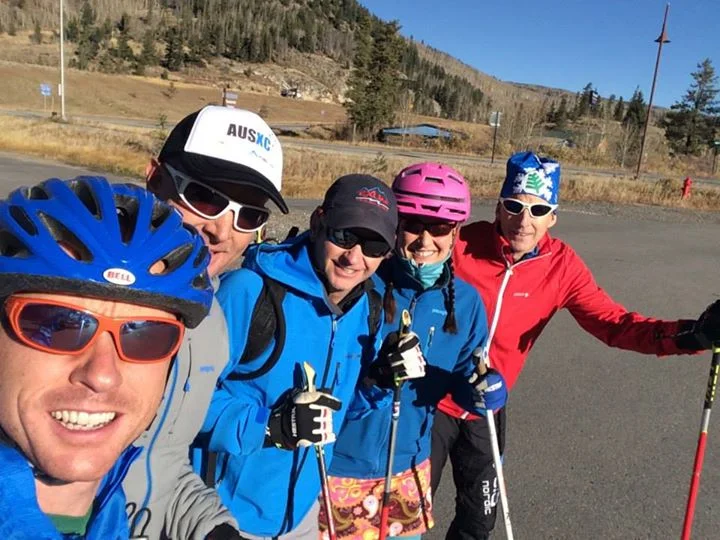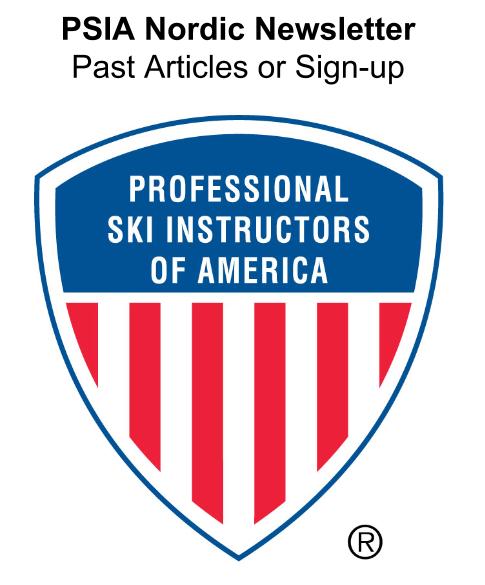PSIA Team Training - 2014 Fall Workshop
/I just returned from PSIA (Professional Ski Instructors of America) all teams Fall Workshop, what we call Team Training.
Team Training represents the major, annual focal point of the 30 member, multidiscipline snow-sports team, a collection of the best US ski instructors from Alpine, Snowboard, Adaptive, Telemark and Cross Country.
All members undergo a multi-day, intense tryout process before being selected as a team member. Once selected, members serve a four year term. During that four year term, team members become the face and voice of American ski teaching, representing the PSIA association and multiple sponsors like Patagonia and Rossignol.
We write manuals, articles, videos all the while seeking and sharing the latest and greatest concepts, techniques, tactics and teaching principles pushing our sports.
As a current member of the PSIA XC Nordic Team, I'm going to give you an insiders view of everything we covered at the PSIA Fall Workshop, Team Training 2014.
There's a LOT of stuff here. Give the article a quick scroll and dive into what interests YOU the most!
State of the Industry Report
Reese Brown from SIA shared his slide deck about the state of the ski industry. You can watch a quick video synapsis of that report.
Two interesting facts I took away from the report...
- Cameras most popular accessory in snow sports
- Participation is 80% weather
PSIA Member Pro Discounts and Gear Highlights
PRO DEALS - as a member of PSIA, you have access to numerous pro discounts on the snowpros.org website. Login with your member number and start shopping (for PSIA members only).
Scotty and Megan in our new Patagonia Simple Guide uniform.
PATAGONIA
My uniform this year is the Simple Guide Pant and Simple Guide Jacket, both of which I love. Great as clinicing and teaching layers. The pants are a more casual fit than standard XC tights. The coat is light and supple. PATAGONIA DUFFEL - Patagonia's luggage is AWESOME! Whatever piece you get, you'll love. My new favorite jacket, the NANO AIR HOODY, is the cold weather, breathable jacket I've been looking for for years. With ultimate breathability, the perfect stretch and a fantastic cut, this will be my go too winter jacket when the temperature dips.
Other news of note: the Patagonia Hybrid Jacket and the whole Patagonia down line is made with duck instead of goose down. To fight the odor, silver is now in all of Patagonia's capilene base layers.
As a PSIA member, you get a 45% discount! Patagonia wants you to buy! So go to www.snowpros.org, login and save!
HESTRA Gloves
These are the greatest gloves manufactured! In fact, they maybe the greatest snowsport gloves manufactured anywhere in the world. I've skied Hestra for 6 years and I would never go back to anything else, even SWIX. The 4 XC gloves I recommend:
- Ergo Grip Windstopper Race
- Windstopper Race Tracker
- Winter Tour Mitt
- Windstopper Action
These gloves are more expensive and ABSOLUTELY worth every cent!
Hestra sources their own cow and goat leathers. Get this, they only make and sell ONE product - gloves! These gloves are practically indestructible and resist the harsh and abrasive friction created between your hand and your cross country ski poles. They don't wear and they do a superlative job of keeping your hands warm!
Rossignol Skis, Poles and Bindings
My skis of choice this year?
Skate Ski = X-IUM SKATING WCS S1
Classic Wax Ski = X-IUM CLASSIC WCS C2
Classic No Wax Ski = X-IUM CLASSIC AR (fish scale ski) and MY FAVORITE X-IUM CLASSIC WCS C2 R-GRIP with the rubber kickzone. These skis hold onto the snow in warm, wet conditions and work well beyond the advertised range.
Nordic Boots = Rossi Pursuit Boot - I ONLY SKI IN ONE BOOT ALL WINTER LONG AND THESE ARE IT FOR ME.
Alpine Boots = All Track 110. These boots provide all day comfort, power and fun on the mountain!
Alpine Bindings = Axil 3 (be sure to buy binding to fit width of ski)
Alpine Ski = Experience 88 ski, all snow, with air tip tech, rounder tip and blended rocker.
Clinic and Ski Topics
Group Placement
notes from Megan Spurkland's clinic
Discussing how to divide skiers into groups at our next clinic.
Often at ski camps and ski clinics, camp leaders group skiers by ability. The usual categories? Never-evers, beginners, intermediates and advanced skiers. Sometimes these categories work, but often skiers feel judged, mis-categorized or hurt by the label.
To avoid that situation, try dividing groups by intensions instead of ability. Example skier intentions might be: FITNESS, SOCIAL, TECHNIQUE or SPECIFIC SKILL FOCUS.
Experiment with skiers self seeding by their intentions.
Or, instead of creating the intensions and asking skiers to self seed, let the skiers discuss why they are attending your clinic and let them create their own groups.
Fits and Posner: Stages of Skill Acquisition
notes from a conversation with Jim Shaw
Jim Shaw discussing Fits and Posner.
Jim Shaw, from the Telemark team, shared with me the Fits and Posner theory of skill acquisition. The theory supposes 3 stages of learning: the cognitive stage, the associative stage, and the autonomous stage.
Each stage represents a distinct phase a learner experiences during skill acquisition.
The Cognitive Stage:
- initial stage of learning
- understanding the nature and/or goal of the activity or activities, creating the right mental image
- requires a high level of concentration and attention
- students need specific instructions to correct errors
- learners will not often know how to correct errors themselves
- lots of practice time & experimentation
The Associative Stage:
- middle stage of learning
- basic skill established
- refinement of skill
- Errors present, but decreasing
- less focus on skill acquisition and more time spent on applying skills in "realtime" situations
The Autonomous Stage:
- final stage of learning
- skill mastery
- skill becomes automatic
- requiring little concentration and attention
- instructor only facilitates the learning situation as the learner corrects ones own errors.
Example Drill Using Fits & Posner's Model:
The Red Line Drill by Chris Fellows (alpine downhill drill)
Chris Fellows making perfect edge changes on the Red Line.
- Try to edge change on an imaginary red line painted down middle of the trail.
- First, as a clinic leader, don't tell the skiers how to do it, but let the skiers experiment.
- Next, as the clinic leader, give each skier a component to work on that's missing in his or her edge change. Jim Shaw called this augmented feedback.
- This approach follows the theory by giving the skiers a mental image to work toward, the "red line." As skiers try the drill, the clinic leader surmises the stage each skier is currently experiencing, giving as much or as little feedback as necessary. He may give a more precise, clearer demo for the learners in the cognitive phase. He may give the associative phase skiers a quick tip or adjustment. The autonomous phase skiers, he might challenge by moving the "red line" into more difficult terrain or off piste.
Although I write and publish for a Nordic community, going outside our sport to explore concepts and teaching tactics creates massive benefits. The point is this, how can you take Fits and Posner's Skill Acquisition Theory and Chris Fellows "Red Line" drill and apply the concepts on nordic skis?
New PSIA Technical Manuals Released
The new PSIA Telemark Manual.
I got to see, touch & read the new PSIA Technical Manuals for Alpine, Snowboard and Telemark. The manuals are beautiful, well organized, bursting with AMAZING insights, descriptions and images. The manuals also include QR codes that the reader scans on a smart phone or tablet to watch a complimentary video!
The Cross Country Nordic manual should release March of this year.
Finally, PSIA is giving Nordic skiing its own manual! The new manual marries USSA's sports performance triangle with PSIA's new nordic skills concept.
The nordic team spent LOT'S of time on the manual, readying it for its first MAJOR review. A photo and video shoot will follow this winter, then another round of edits.
The manuals will be available in both digital and physical copies.
XC Drills
Put Your Ski "Under Pressure"
adopted from Scotty McGee & Ross Matlock
The "Under Pressure" drill is meant as a "guided discovery" exercise to "turn on" the skier's senses in the foot by applying various forces along the axis of the ski.
Scotty McGee and Megan Spurkland at 12,000 feet, Cooper Mountain, CO. PSIA Team Training 2014.
- On classic or skate skis, try to land on tail first and then pressure the ski back to front.
- Next, try to land on the middle of the ski and pressure the ski middle to front.
- Finally, try to land on the front of your ski, pushing pressure along the front of the ski.
- As you experiment with the various pressuring combinations, explore what the ankle does in each scenario. How about your toes? Try landing on your ski with toes up, toes down and toes flat.
- During this guided discovery exercise, the debrief is as important as the exercise. What did you discover? Any new revelations or drill possibilities occur to you? What pressure combination produces the maximum amounts of force? What pressure combinations result in the greatest energy effeciencies? What particular fundamental movements do you use for the greatest effect?
The "HI" Drill
notes from Megan Spurkland's clinic
Megan clinicing the team on the "HI" drill.
- Pretend the letter "H" is printed on your left cheek and the letter "I" is printed on your right cheek (the cheeks you sit on, not the cheeks on your face). In other words, pretend "HI" is written across your arse!
- When you classic ski, as Megan says, "Show your britches to the ditches!"
- Imagine the people standing on the side of the trail can read the word "HI" when you ski beside them.
- The drill forces you to recruit more hip movement into your diagonal stride.
Rapid Skill Acquisition
by David Lawrence
I presented on recent neurological research that describes how we learn. I also outlined numerous ways to "hack" or shortcut learning, making learning faster and more effective.
My presentation will be printed in Master Skier, winter 2014-2015... stay tuned!
David Lawrence taking a selfie before clinicing on rapid skill acquisition.
In the meantime, I'll share one of the most effective learning hacks I use to strengthen and refine my skiing skills...
Frequency Adaptation Intervals
That's my fancy way of saying "short but frequent practice intervals." NOTE: these are "practice" intervals NOT "training" intervals!
The neurological wiring process of the body and brain happens through a process called frequency adaptations. It means that the body and mind on a cellular level make physical changes in response to repetitive behaviors. Not surprising news. BUT the good news is this, it doesn't take hours of practice everyday to force these adaptations!
Short 5 to 10 minute daily practice sessions, intensely focused, create long lasting adaptations.
To take advantage of this surprising finding, try this:
- Create a 5 to 10 minute skill routine and do it at the start of every ski session.
- Frequency Adaptation Intervals can double as both a dynamic warm-up routine and as skill acquisition practice.
Using about a 10 rep or 20-30 second focus with each exercise on both the right and left side (either skate or classic), my routine is as follows:
- Long, slow strides
- Fast, quick strides
- Double pole slow with a full range of motion in the upper and lower body
- Double pole fast with a full range of motion
- Double pole only using arms
- Double pole using one arm at a time
- Double pole only using abs
- No pole striding/skating with long, slow, exaggerated leg movements (push-off)
- No pole striding/skating with fast, quick, truncated leg movements
- No pole striding/skating balancing as long as you can, extending your glide before moving onto the next ski
- Transition and move through every technique as slow and as exaggerated as you can for the kind of skiing your doing.
Example classic: diagonal stride, kick double pole, double pole, herringbone, step turns left and right, skate turns left and right.
Example skate: V1 left and V1 right, V1 one pole strong side then offside, left side and right side, V2, V2A, double pole, step turns right and left, skate turns left and right. - Skip and hop on both skis, then skip and hop on one ski at a time. Skip and hop in every technique as listed in exercise #11.
The Pause
from Megan Spurkland's roller ski clinic
The "Pause Drill" gets beginner & intermediate classic skiers to glide longer with each stride by delaying the pole plant.
NOTE: the "Pause" implies actually pausing your arms before you plant your pole. HOWEVER, that is NOT what the drill is trying to do. Instead, keep the arms and hands moving throughout the poling cycle!
- The Pause - stride onto one ski and plant pole tip simultaneously (in other words, plant the pole when your ski lands on the snow).
- Next, stride onto one ski, glide for a moment and then plant pole tip into snow.
- To help you or your students/athletes with the timing, say "Glide" when you land on your ski, then say "Pole" when you plant your pole. Delaying the sequence by saying, "Glide" and then "Pole" can help skiers with the timing of this drill.
The PSIA Interski Message
Interski 2016!
Every four years, the skiing nations of the world gather to share ski teaching philosophies and report on the state of the industry in each of the respective countries. Countries exchange ideas and best practices through keynote presentations, on snow ski clinics and in personal exchanges and conversations over meals or drinks.
Next year, 2016, Argentina will host Interski in Ushuaia. In preparation, PSIA started crafting the US message to bring abroad.
Here is a quick snapshot of our discussion...
What are the key principles of US ski teaching? The use of 3 primary skills that instructors and coaches develop, practice and refine...
- People Skills
- Teaching Skills
- Technical Skills
Supporting each of the three skills listed above, are 3 key ingredients that broadly categorize the kind information ski instructors and coaches access for professional development that support each skill...
- CORE - the fundamental core concepts of people skills, teaching skills and technical skills.
The core concepts of teaching skills and people skills for ski instructors of all disciplines are collected in PSIA's Core Concepts Manual (a manual with TONS of information about how we learn, how to communicate, how to teach and how the body moves).
The core concepts of technical skills are collected for each discipline in sport specific Technical Manuals (each manual explaining the core technical skills required to master each ski discipline), The Movement Matrix (videos with narration showing and explaining the core technical skills) and PSIA's printed magazine 32 Degrees (a magazine full of articles touching on the core of the three skills mentioned above).
- Culture - people skills, teaching skills and technical skills all exist in a specific frame of reference, what we call culture. Technical snowboard skills must be considered in the culture of snowboard freestylers, park riders or retired CEO's. The culture determines the context of the skills of teaching, people and technical. Culture also relates to the country in which the skills are taught and used. Culture is context.
- Connections - is how we create meaning and associations. Connections is about bringing to life the three skills.
Possible Articles You Might See Come Out of PSIA
- Certification Secrets: Stay Fit, Stay Resilient, Develop a Growth Mindset, Develop Learning Strategies, Develop an Experimental Mindset, Go Outside the Industry
- January is Learn to Ski Month! Make Your January "Become a Better Ski Instructor Month!"
- Make Your College Degree Irrelevant: Become a Professional Ski Instructor That Can Actually Support a Family!
- How to Make Your Students Active Learners Instead of Passive Learners
PSIA XC Nordic AcademyWest Yellowstone, November 30-December 2, 2014
Directly after the Yellowstone Ski Festival
$290, includes Reception, All sessions, apres, banquet
XC Academy 2014 features three days of formal indoor and on-snow presentations sharing the best of ideas, topics and issues to get you geared-up for the 2014-2015 season. Collaborate with the PSIA Nordic Team, NRM Ed Staff, XC instructors, trainers, school directors, and coaches from across the country on West Yellowstone's Rendezvous Trails.
PSIA XC Academy, learn more here.
http://www.xcskiacademy.com/schedule/psia-xc-nordic-ski-academy
